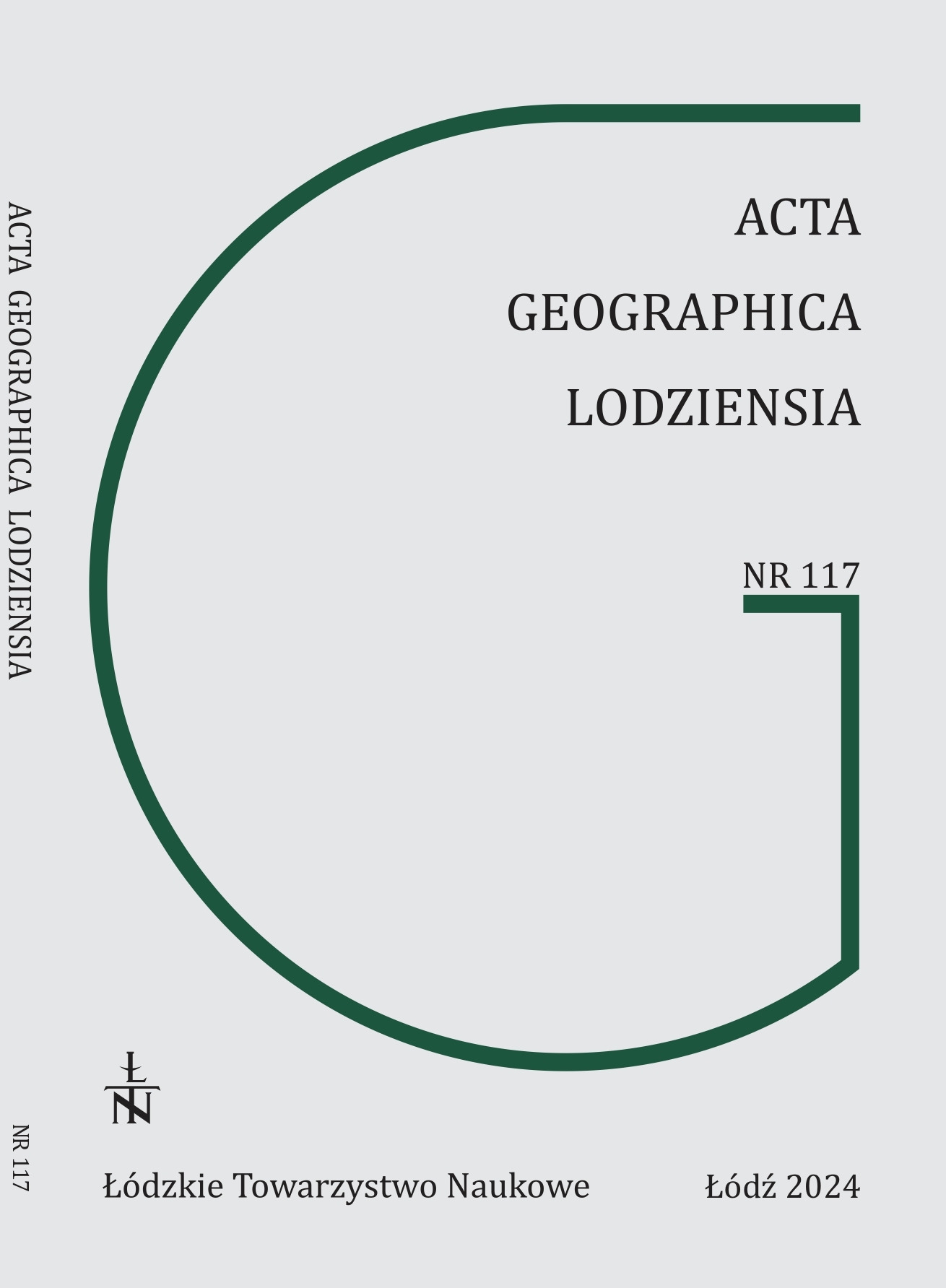The characteristics of meteorological conditions and atmospheric instability conditions on selected thunderstorm days in Łódź in 2019–2023
DOI:
https://doi.org/10.26485/AGL/2024/117/7Keywords:
storms, instability conditions, convective potential energy, instability indicesAbstract
The main goal of this work is to characterise the values of atmospheric instability indicators on storm days in Łódź. The assessment of atmospheric instability indices and the probability of thunderstorms were based on instability indices: the CAPE (Convective Available Potential Energy), KI, TTI (Total Totals Index) and SWEAT (Severe Weather Treat Index) indices. These indicators were determined on the basis of radio soundings carried out at two aerological stations in Legionowo and Wrocław, located 120 km and 185 km from Łódź, respectively. The research was based on 90 storm events in 2019–2023.
The results showed that the analysed indicators reached high values indicating high instability and high probability of storms. The median value for the summer months of the KI index reached the level of 30–32 and the TTI index was 45–48. These values clearly indicate strong atmospheric instability and a high probability of storms. However, the characteristics of the CAPE index showed that storms occurred with a very large variation in the value of this index. The determined median values (for measurements performed during daylight hours) were in the range of 100–500 J·kg˗1.
References
Allen J. T. 2018. Climate change and severe thunderstorms. Oxford Research Encyclopedia of Climate Science, Oxford University Press.
Bąkowski R. 2005. Wybrane analityczne i prognostyczne wskaźniki chwiejności atmosfery. W: M. Ozga-Zielińska, D. Limanówka (red.) Hydrologia, meteorologia i klimatologia: badania naukowe i prognozy w erze informatyzacji. Seria Monografie. Wyd. IMGW-PIB, Warszawa: 209-218.
Bielec-Bąkowska Z., Bąkowski R. 2006. Wskaźniki chwiejności atmosfery a występowanie silnych zjawisk konwekcyjnych na przykładzie Warszawy. Annales Universitatis Mariae Curie-Skłodowska. Sectio B: Geographia, Geologia, Mineralogia et Petrographia 61: 65-71.
Brooks H.S. 2013. Severe thunderstorms and climate change. Atmospheric Research 123: 129-138.
Celiński-Mysław D., Palarz A. 2017. Ekstremalne wartości wskaźników chwiejności atmosfery w Polsce i ich związek z mechanizmami ograniczającymi rozwój konwekcji. Prace Geograficzne 148: 11-32.
Costa S., Mezzasalma P., Levizzani V., Alberoni P.P., Nanni S. 2001. Deep convection over Northern Italy: synoptic and thermodynamic analysis. Atmospheric Research 56: 73-88.
Craven J.P., Jewell R.E., Brooks H.E. 2002. Comparison between observed convective clode-base heights and lifting condensation level for two different lifted parcels. Weather Forecasting 17: 885-890.
Dalezios N.R., Papamanolis N.K. 1991. Objective assessment of instability indices for operational forecasting in Greece. Meteorology and Atmospheric Physics 45: 87-100.
Department of Atmospheric Science University of Wyoming. 2023. Online: https://weather. uwyo.edu/upperair/sounding.html (data ostatniego dostępu: 30.11.2023)
Haklander A., Delden A. 2003. Thunderstorm predictors and their forecast skill for the Netherlands. Atmospheric Research 67–68: 273-299.
Huntriser H., Schiesser H.H., Schmid W., Waldvogel A. 1996. Comparison of traditional and newly developed thunderstorm indices for Switzerland. Weather Forecasting 12: 108-125.
IMGW-PIB (Instytut Meteorologii i Gospodarki Wodnej – Państwowy Instytut Badawczy) 2024. Online: https://klimat.imgw.pl/pl/biuletyn-monitoring/ (data ostatniego dostępu: 17.01.2024).
Jacovides C.P., Yonetani T. 1990. An evaluation of stability indices for thunderstorm prediction in Greater Cyprus. Weather Forecasting 5: 559-569.
Kafar M. 1998. Charakterystyka wybranych zjawisk atmosferycznych w Łodzi w latach 1951–1992. Acta Univesitatis Lodziensis – Folia Geographica Phisica 3: 279-295.
Kunz M. 2007. The sill of convective parameters and indices to predict isolated and severe thunderstorms. Natural Hazards and Earth System Sciences 7: 327-342.
Kolendowicz L. 2006. The Influence of Synoptic Situations on the Occurrence of Days with Thunderstorms During a Year in the Territory of Poland. International Journal of Climatology 26: 1803-1820.
Kolendowicz L. 2012. Synoptic Patterns associated with thunderstorms in Poland. Meteorologische Zeitschrift 21(2): 145-156.
Manzato A. 2003, A climatology of instability indices derived from Friuli Venezia Giulia soundings, using three different methods. Atmospheric Research 67–68: 417-454.
OGIMET. 2024. Online: https://ogimet.com/ home.phtml.en (data ostatniego dostępu: 05.01.2024)
Pešice P., Sulan J., Řezáčová D. 2003. Convection precursor in the Czech territory. Atmospheric Research 67–68: 523-532.
Rasmussen E.N., Blanchard D.O. 1998. A baseline climatology of sounding-derived supercell and tornado forecast parameters. Weath-er Forecasting 13: 1148-1164.
Siedlecki M. 2011. Charakterystyka chwiejności atmosfery. Acta Unversitatis Lodziennsis – Folia Geographica Physica 11: 1-185
Taszarek M., Czernecki B., Kozioł A. 2015. A Cloud-to-Ground Lightning Climatology for Poland. Monthly Weather Review 143(11): 4285-4304.
Taszarek M., Allen J., Púčik T., Groenemeijer P., Czernecki B., Kolendowicz L., Lagouvardos K., Kotroni V., Schulz W. 2019. A Climatology of Thunderstorms across Europe from a Synthesis of Multiple Data Sources. Journal of Climate 32: 1813-1837.
Van Delden A. 2001. The synoptic setting of thunderstorms in western Europe. Atmospheric Research 56(1–4): 89-110.
Downloads
Published
How to Cite
Issue
Section
License
Copyright (c) 2024 Łódzkie Towarzystwo Naukowe

This work is licensed under a Creative Commons Attribution-NonCommercial-NoDerivatives 4.0 International License.



